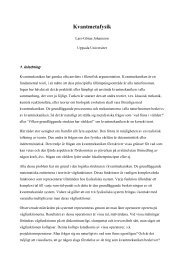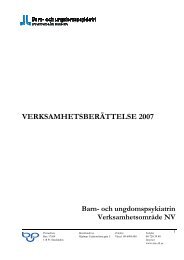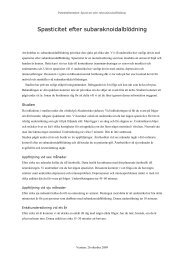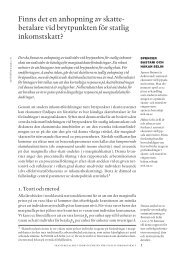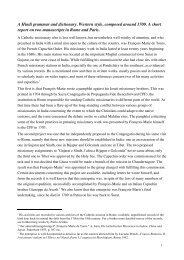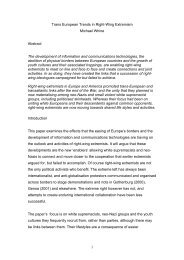Myth-Busting: What Enterprise Architecture Is Not November 3-7 ...
Myth-Busting: What Enterprise Architecture Is Not November 3-7 ...
Myth-Busting: What Enterprise Architecture Is Not November 3-7 ...
You also want an ePaper? Increase the reach of your titles
YUMPU automatically turns print PDFs into web optimized ePapers that Google loves.
<strong>Myth</strong>-<strong>Busting</strong>: <strong>What</strong> <strong>Enterprise</strong> <strong>Architecture</strong><br />
<strong>Is</strong> <strong>Not</strong><br />
Symposium/ITxpo 2008<br />
<strong>November</strong> 3-7, 2008<br />
Palais des Festivals<br />
Cannes, France<br />
For more information about our research policies, processes and methodologies,<br />
please visit Gartner Research Methodology on gartner.com.<br />
These materials can be reproduced only with written approval from Gartner.<br />
Such approvals must be requested via e-mail: vendor.relations@gartner.com.<br />
<strong>November</strong> 3-7, 2008<br />
Cannes, France<br />
Betsy Burton
<strong>Myth</strong>-<strong>Busting</strong>: <strong>What</strong> <strong>Enterprise</strong> <strong>Architecture</strong> <strong>Is</strong> <strong>Not</strong><br />
Perceptions of <strong>Enterprise</strong><br />
<strong>Architecture</strong> (EA)<br />
This presentation, including any supporting materials, is owned by Gartner, Inc. and/or its affiliates and is for the sole use of the<br />
intended Gartner audience or other authorized recipients. This presentation may contain information that is confidential,<br />
proprietary or otherwise legally protected, and it may not be further copied, distributed or publicly displayed without the express<br />
written permission of Gartner, Inc. or its affiliates. © 2008 Gartner, Inc. and/or its affiliates. All rights reserved.<br />
"It seems like those architects are<br />
in an ivory tower telling us how to<br />
do our jobs."<br />
"I really don't want to get the<br />
EA team involved."<br />
"<strong>Enterprise</strong> architecture is<br />
too big and broad."<br />
"I see the output – but not a<br />
lot of business value."<br />
"Our management won't let us<br />
use the words 'enterprise<br />
architecture.'"<br />
Misperceptions regarding the role of EA abound in most organizations, resulting in conflicts, as well as<br />
resentment between the EA team and other groups. These issues are fueled by EA urban legends that have<br />
taken on a life of their own and that continue to be professed as truths by pundits and practitioners. The key is<br />
to increase collaboration between business, IT and architects by clearly communicating what EA is — and<br />
equally what EA is not — and to debunk the common EA urban legends. We have found that, to be effective:<br />
• The EA team must leverage the strategic guidance from a business strategy and the specific tactical<br />
guidance from the business plan to guide their EA efforts overall.<br />
• EA teams should serve as advisors to the IT strategic planning effort, along with the CTO, senior IT staff,<br />
business leaders and users.<br />
• EA teams must participate in performance management efforts relating to critical business processes.<br />
• <strong>Enterprise</strong> architects do not dictate implementation details for the entire organization or for specific<br />
practice areas.<br />
In a well-architected enterprise, EA is the coordinating process that ensures that the other strategic and<br />
management processes of the enterprise are in sync with respect to the future state.<br />
Betsy Burton<br />
ESC20_666, 11/08, AE<br />
Page 1
<strong>Myth</strong>-<strong>Busting</strong>: <strong>What</strong> <strong>Enterprise</strong> <strong>Architecture</strong> <strong>Is</strong> <strong>Not</strong><br />
Key <strong>Is</strong>sues<br />
1. How does Gartner define "enterprise<br />
architecture?"<br />
2. <strong>What</strong> EA is not. And, how does EA relate to<br />
other IT and business initiatives?<br />
3. How can architects ensure that they deliver the<br />
highest value and impact to business and IT?<br />
Gartner's definition of EA (see "Gartner Defines the Term '<strong>Enterprise</strong> <strong>Architecture</strong>'") reflects the goals and<br />
aspirations of most enterprise architects who are familiar with EA processes, methodologies and artifacts. It<br />
describes EA as an actionable and practical process and approach. EA is a collaborative process that facilitates<br />
discussion and resolution between diverse groups of stakeholders across the enterprise, with the objective of<br />
ensuring a consistent approach to the execution of the business strategy. However, in many organizations, EA<br />
initiatives are often perceived by those outside the practice area as vague, too broad and overlapping other<br />
functions. IT and business people will often express concern that EA is an effort by a group that is divorced<br />
from day-to-day realities to "control" what they do and "impede" their efforts. As a result, their interactions<br />
with enterprise architects is commonly clouded with suspicion, wariness and even disdain.<br />
This presentation, including any supporting materials, is owned by Gartner, Inc. and/or its affiliates and is for the sole use of the<br />
intended Gartner audience or other authorized recipients. This presentation may contain information that is confidential,<br />
proprietary or otherwise legally protected, and it may not be further copied, distributed or publicly displayed without the express<br />
written permission of Gartner, Inc. or its affiliates. © 2008 Gartner, Inc. and/or its affiliates. All rights reserved.<br />
Betsy Burton<br />
ESC20_666, 11/08, AE<br />
Page 2
<strong>Myth</strong>-<strong>Busting</strong>: <strong>What</strong> <strong>Enterprise</strong> <strong>Architecture</strong> <strong>Is</strong> <strong>Not</strong><br />
Key <strong>Is</strong>sue: How does Gartner define "enterprise architecture?"<br />
Gartner 2006 Definition of<br />
<strong>Enterprise</strong> <strong>Architecture</strong><br />
• <strong>Enterprise</strong> architecture is…<br />
… the process (it's a process AND a thing)…<br />
… of translating business vision and strategy…<br />
… into effective enterprise change (if no change is needed, then no architecture is<br />
needed)…<br />
… by creating, communicating and improving the key requirements, principles and models<br />
that describe the enterprise's future state and that enable its evolution<br />
(architecture produces the creative constraints that bound implementation decisions).<br />
• The scope of the enterprise architecture includes…<br />
… the people, processes, information and technology of the enterprise,<br />
(architecture is NOT just about technology)…<br />
… and their relationships to one another and to the external environment.<br />
• <strong>Enterprise</strong> architects compose…<br />
… holistic solutions…<br />
… that address the business challenges of the enterprise…<br />
… and support the governance needed to implement them.<br />
<strong>Enterprise</strong> architecture means architecting the enterprise<br />
to enable change.<br />
<strong>Enterprise</strong>s undertake the process of enterprise architecture for a variety of reasons. Some want to reduce<br />
technology diversity. Others want to simplify a complex application landscape. Others want to improve time to<br />
market for new products, or take a more-strategic approach to a transformation initiative. <strong>What</strong>ever the reason<br />
for initiating an enterprise architecture program, there is one common objective: change.<br />
In May 2006, Gartner ratified a standard definition of EA. This definition represents the consensus opinion of<br />
the entire Gartner EA research community on the scope and purpose of EA. EA has always been focused on<br />
enhancing enterprise agility. We have long stated that EA must facilitate change. The key is to create, not the<br />
perfect or elegant architecture for the moment, but the most adaptable architecture for the future. EA is a<br />
challenging discipline, made more so by its potential scope and reach. Careful attention to the basics can mean<br />
the difference between success and failure.<br />
This presentation, including any supporting materials, is owned by Gartner, Inc. and/or its affiliates and is for the sole use of the<br />
intended Gartner audience or other authorized recipients. This presentation may contain information that is confidential,<br />
proprietary or otherwise legally protected, and it may not be further copied, distributed or publicly displayed without the express<br />
written permission of Gartner, Inc. or its affiliates. © 2008 Gartner, Inc. and/or its affiliates. All rights reserved.<br />
Betsy Burton<br />
ESC20_666, 11/08, AE<br />
Page 3
<strong>Myth</strong>-<strong>Busting</strong>: <strong>What</strong> <strong>Enterprise</strong> <strong>Architecture</strong> <strong>Is</strong> <strong>Not</strong><br />
The Gartner EA Process<br />
Organize <strong>Architecture</strong> Effort<br />
Environmental Trends<br />
Develop<br />
Requirements<br />
Architecting<br />
Develop<br />
Principles<br />
Future-State <strong>Architecture</strong><br />
Governing and Managing<br />
Current-State <strong>Architecture</strong><br />
Documenting<br />
This presentation, including any supporting materials, is owned by Gartner, Inc. and/or its affiliates and is for the sole use of the<br />
intended Gartner audience or other authorized recipients. This presentation may contain information that is confidential,<br />
proprietary or otherwise legally protected, and it may not be further copied, distributed or publicly displayed without the express<br />
written permission of Gartner, Inc. or its affiliates. © 2008 Gartner, Inc. and/or its affiliates. All rights reserved.<br />
Business Strategy<br />
Develop<br />
Models<br />
Betsy Burton<br />
ESC20_666, 11/08, AE<br />
Closing<br />
the Gap<br />
Key <strong>Is</strong>sue: How does Gartner define "enterprise architecture?"<br />
EA is an iterative process that produces four major deliverables: 1) a future-state architecture, which supports<br />
the requirements of the business strategy and external environmental factors expressed in the business context;<br />
2) documentation of the current-state architecture (to the minimal level of detail required); 3) a gap analysis<br />
that identifies the shortfalls of the current state in terms of its ability to support the strategies of the enterprise;<br />
and 4) a road map defining the steps that should be taken to evolve the current state into the future state.<br />
Control of the execution of the road map — decisions with respect to the allocation of funds and resources —<br />
are not made within the architecture itself, but are the function of other management disciplines that are related<br />
to, but not part of, the architecture.<br />
A future-state architectural vision is developed through a process of defining requirements, developing<br />
principles and building models at various levels of abstraction. This is followed by documentation of the<br />
current state (to the minimum level of detail required). Finally, a road map is developed, which defines how<br />
the enterprise will evolve from the current-state to the future-state architecture, and the evolution is achieved<br />
through a governance process and structure, which ensures that the decisions of the EA are acted on as new<br />
capabilities are built and new investments are made in technology.<br />
Page 4
<strong>Myth</strong>-<strong>Busting</strong>: <strong>What</strong> <strong>Enterprise</strong> <strong>Architecture</strong> <strong>Is</strong> <strong>Not</strong><br />
The Gartner EA Framework<br />
Solution<br />
<strong>Architecture</strong><br />
Key <strong>Is</strong>sue: How does Gartner define "enterprise architecture?"<br />
As we indicated previously, the EA is overlaid by the business context, which is derived from the business<br />
strategy and the external factors that affect the enterprise. Within the EA, Gartner has adopted an "aspect<br />
oriented" approach, similar to the approach espoused in the IEEE's "Recommended Practice for Architectural<br />
Description of Software-Intensive Systems" (IEEE 1471-2000), which proposes that the architecture is a<br />
collection of "viewpoints" — architectural descriptions that satisfy the perspectives of each individual<br />
stakeholder. In Gartner's approach, an EA has a minimum of three viewpoints: 1) a business viewpoint, which<br />
is concerned with functional, process and organizational views of the enterprise; 2) an information viewpoint,<br />
which is concerned with the information required to run the enterprise, the logic that manipulates the<br />
information and the mechanisms that allow for integration of that information across diverse processes; and 3)<br />
a technology viewpoint, which is concerned with the infrastructural components, both hardware and software,<br />
that support the enterprise. These viewpoints are derived from the business context and should demonstrate<br />
clear traceability of architectural decisions to the elements of the business strategy. The crux of the framework<br />
is the "solutions architecture," which represents the intersection of the business, information and technology<br />
viewpoints. Here, we find the architectural guidance required to build solutions, where the relationships<br />
between components in different viewpoints are needed (for example, the application partition model, which<br />
shows how the business functions of the enterprise are supported by the application portfolio).<br />
This presentation, including any supporting materials, is owned by Gartner, Inc. and/or its affiliates and is for the sole use of the<br />
intended Gartner audience or other authorized recipients. This presentation may contain information that is confidential,<br />
proprietary or otherwise legally protected, and it may not be further copied, distributed or publicly displayed without the express<br />
written permission of Gartner, Inc. or its affiliates. © 2008 Gartner, Inc. and/or its affiliates. All rights reserved.<br />
Betsy Burton<br />
ESC20_666, 11/08, AE<br />
Page 5
<strong>Myth</strong>-<strong>Busting</strong>: <strong>What</strong> <strong>Enterprise</strong> <strong>Architecture</strong> <strong>Is</strong> <strong>Not</strong><br />
Key <strong>Is</strong>sue: <strong>What</strong> EA is not. And, how does EA relate to other IT and business initiatives?<br />
Strategic Planning Guideline: EA supports the development of a business strategy. However,<br />
the ultimate decision rights on the business strategy and business plans are with business<br />
leaders and senior executives, not the EA team.<br />
EA Supports the Development of a<br />
Business Strategy<br />
Strategic target<br />
Industrywidemultisegment<br />
Particular<br />
segment<br />
Differentiation<br />
This presentation, including any supporting materials, is owned by Gartner, Inc. and/or its affiliates and is for the sole use of the<br />
intended Gartner audience or other authorized recipients. This presentation may contain information that is confidential,<br />
proprietary or otherwise legally protected, and it may not be further copied, distributed or publicly displayed without the express<br />
written permission of Gartner, Inc. or its affiliates. © 2008 Gartner, Inc. and/or its affiliates. All rights reserved.<br />
Strategic advantage<br />
Uniqueness<br />
perceived by<br />
the customer<br />
Focus<br />
Low-cost<br />
position<br />
Overall cost<br />
leadership<br />
source: Source: Porter, competitive strategy<br />
EA is not a business strategy.<br />
A business strategy is defined by business leaders and senior executives, and it articulates the business goals<br />
and directions of the organization overall, along with the strategic directions the business will pursue. The<br />
business plan turns strategies into specific tactical plans designed to achieve the strategic goals. The EA team<br />
must leverage the strategic guidance from the business strategy and specific tactical guidance from the<br />
business plans to guide their EA efforts overall. Gartner refers to this activity as "creating the business context<br />
for the architecture," and a critical deliverable of this effort is the common requirements vision (CRV — see<br />
"Advancing the Common Requirements Vision Deliverable"). This document can be leveraged by the business<br />
strategy and planning efforts, because it clearly identifies the changes required in the enterprise to support the<br />
strategy. This information is invaluable when evaluating what business options are achievable and determining<br />
how to change/evolve the business.<br />
The challenge is that many organizations struggle with defining a clear and focused business strategy (see<br />
"Findings: EA Should Be Driven by Business Objectives"). In such cases, the architecture team needs to work<br />
with business and senior executives to help them articulate the strategy in an actionable way. Business and<br />
senior executives should take the lead, but EA must support and help these efforts.<br />
Betsy Burton<br />
ESC20_666, 11/08, AE<br />
Page 6
<strong>Myth</strong>-<strong>Busting</strong>: <strong>What</strong> <strong>Enterprise</strong> <strong>Architecture</strong> <strong>Is</strong> <strong>Not</strong><br />
Strategic Planning Guideline: The IT strategic planning team leverages critical architecture<br />
artifacts, including the CRV (to provide overall strategic context for the IT strategy), the<br />
future-state view of the enterprise, and the gap analysis and road map that define the<br />
migration from the current state to the desired future state.<br />
EA Teams Should Serve as Advisors Into<br />
IT Strategic Planning<br />
An IT strategic plan commonly addresses:<br />
• Sourcing options and strategies<br />
• Service delivery plans and service-level agreements (SLAs)<br />
• Vendor management plans<br />
• How resources should be allocated<br />
• IT organizational structure and governance<br />
• IT training, recruiting and mentoring programs<br />
• IT functional plans (integrating new technologies, data formats,<br />
service delivery models, acquisition cycles)<br />
Strategic<br />
Direction<br />
Strategic<br />
Initiatives<br />
Project<br />
Plans<br />
3 to 5 Years 18 Months 1 Year Today<br />
This presentation, including any supporting materials, is owned by Gartner, Inc. and/or its affiliates and is for the sole use of the<br />
intended Gartner audience or other authorized recipients. This presentation may contain information that is confidential,<br />
proprietary or otherwise legally protected, and it may not be further copied, distributed or publicly displayed without the express<br />
written permission of Gartner, Inc. or its affiliates. © 2008 Gartner, Inc. and/or its affiliates. All rights reserved.<br />
Benefits<br />
Realization<br />
IT Strategy Evolves From Goals to Results<br />
EA is not IT strategic planning.<br />
Key <strong>Is</strong>sue: <strong>What</strong> EA is not. And, how does EA relate to other IT and business initiatives?<br />
EA and IT strategic planning are complementary efforts that must be coordinated and integrated, but they are<br />
not the same. IT strategic planning is the vehicle that sets long-term goals for the IT organization; it establishes<br />
the directions and constraints that will guide the tactical achievement of these goals, and it identifies the assets<br />
and capabilities that the IT organization has to acquire, and how, in order to execute the plan. IT strategic<br />
planning integrates the strategic intent of the business with the IT organization's delivery options, capabilities,<br />
priorities and commitments.<br />
Although IT strategic planning is most often led by a CIO, EA teams should serve as advisors into IT strategic<br />
planning, along with the CTO, senior IT staff, and business leaders and users.<br />
Betsy Burton<br />
ESC20_666, 11/08, AE<br />
Page 7
<strong>Myth</strong>-<strong>Busting</strong>: <strong>What</strong> <strong>Enterprise</strong> <strong>Architecture</strong> <strong>Is</strong> <strong>Not</strong><br />
Strategic Planning Guideline: EA provides the future-state road map, and the principles,<br />
standards and guidelines provide the decision criteria that ITG uses to make investment<br />
decisions.<br />
ITG Builds on an Effective EA Initiative<br />
(<strong>What</strong> Should IT Work On?)<br />
Demand<br />
Governance<br />
Business Management Primary Responsibility<br />
Plan Implement Manage Monitor<br />
Business IT<br />
Strategy<br />
Validation<br />
Business/IT<br />
Operational<br />
Planning<br />
Overall<br />
IT Investment<br />
and Expense<br />
Develop Demand<br />
Governance<br />
Processes<br />
Demand<br />
Governance<br />
Implementation<br />
Councils/<br />
Committees<br />
IT Investment<br />
Portfolios<br />
(PPM)<br />
Investment<br />
Evaluation<br />
Criteria<br />
IT Service<br />
Chargeback<br />
Business Unit<br />
Prioritization<br />
Intra-/Inter-<br />
<strong>Enterprise</strong><br />
Prioritization<br />
<strong>Is</strong>sue Escalation/<br />
Resolution<br />
Funding/<br />
Chargeback<br />
Board IT<br />
Governance<br />
Spending/<br />
Project<br />
Oversight<br />
Business Benefits<br />
Realization<br />
IT Value<br />
Assessment<br />
IT Governance<br />
Effectiveness<br />
(Metrics, etc.)<br />
Strategy<br />
IT<br />
Governance<br />
This presentation, including any supporting materials, is owned by Gartner, Inc. and/or its affiliates and is for the sole use of the<br />
intended Gartner audience or other authorized recipients. This presentation may contain information that is confidential,<br />
proprietary or otherwise legally protected, and it may not be further copied, distributed or publicly displayed without the express<br />
written permission of Gartner, Inc. or its affiliates. © 2008 Gartner, Inc. and/or its affiliates. All rights reserved.<br />
Security<br />
Corporate<br />
Compliance<br />
Sourcing<br />
Etc.<br />
• Goals<br />
• Domains<br />
• Principles<br />
• Decision Rights<br />
EA is not IT governance.<br />
(How Should IT Do <strong>What</strong> It Does?)<br />
Supply<br />
Governance<br />
IT Management Primary Responsibility<br />
IT Supply Governance Domains<br />
• Plan<br />
• Implement<br />
• Manage<br />
• Monitor Compliance<br />
• Plan<br />
• Implement<br />
• Manage<br />
• Monitor Compliance<br />
• Plan<br />
• Implement<br />
• Manage<br />
• Monitor Compliance<br />
• Plan<br />
• Implement<br />
• Manage<br />
• Monitor Compliance<br />
<strong>Architecture</strong><br />
Project<br />
Management<br />
Procurement<br />
Betsy Burton<br />
ESC20_666, 11/08, AE<br />
• Plan<br />
• Implement<br />
• Manage<br />
• Monitor Compliance<br />
• Plan<br />
• Implement<br />
• Manage<br />
• Monitor Compliance<br />
• Plan<br />
• Implement<br />
• Manage<br />
• Monitor Compliance<br />
Key <strong>Is</strong>sue: <strong>What</strong> EA is not. And, how does EA relate to other IT and business initiatives?<br />
Gartner defines "IT governance" (ITG) as "the processes that ensure the effective and efficient use of IT in<br />
enabling an organization to achieve its goals." ITG is composed of processes with the inputs, outputs, roles and<br />
responsibilities that are inherent in a process definition. One of the models we use to represent ITG is the<br />
Gartner IT Governance Demand/Supply Model (see "Defining IT Governance: The Gartner IT Governance<br />
Demand/Supply Model"), which illustrates the role of an IT governance strategy relative to demand<br />
governance (for example, what the IT organization should work on) and supply governance (for example, how<br />
the IT organization does its work). The IT governance strategy is developed from the articulation of the<br />
business strategy in the CRV, ensuring alignment with strategic goals.<br />
Page 8
<strong>Myth</strong>-<strong>Busting</strong>: <strong>What</strong> <strong>Enterprise</strong> <strong>Architecture</strong> <strong>Is</strong> <strong>Not</strong><br />
Tactical Planning Guideline: Part of the discipline of program management is to make sure<br />
that the projects are executed in a way that adheres to the standards, guidelines and<br />
principles that are created as part of the EA effort.<br />
Program Management Ensures That<br />
Projects Follow EA Guidance<br />
Project management<br />
ensures that a<br />
specific project<br />
delivers on time and<br />
on budget.<br />
Program<br />
management is the<br />
art of ensuring that<br />
multiple related<br />
projects deliver a<br />
desired strategic<br />
outcome.<br />
Project<br />
Project<br />
A<br />
A temporary endeavor,<br />
undertaken to create a<br />
unique result<br />
EA is not program management.<br />
This presentation, including any supporting materials, is owned by Gartner, Inc. and/or its affiliates and is for the sole use of the<br />
intended Gartner audience or other authorized recipients. This presentation may contain information that is confidential,<br />
proprietary or otherwise legally protected, and it may not be further copied, distributed or publicly displayed without the express<br />
written permission of Gartner, Inc. or its affiliates. © 2008 Gartner, Inc. and/or its affiliates. All rights reserved.<br />
Program<br />
Program X<br />
C<br />
A<br />
E<br />
B<br />
D<br />
Multiple related projects<br />
where the coordinated<br />
outcome is greater than<br />
the sum of the<br />
individual project<br />
outcomes<br />
Key <strong>Is</strong>sue: <strong>What</strong> EA is not. And, how does EA relate to other IT and business initiatives?<br />
Gartner defines program management as the coordinated planning, management and execution of multiple<br />
related projects that are directed toward the same strategic, business or organizational objectives. EA is a<br />
planning discipline, while program management is a discipline of execution. EA is responsible for defining the<br />
future state of the enterprise, analyzing the gaps between the current state and the future state, and developing<br />
the standards and guidelines that support the realization of the future state.<br />
Betsy Burton<br />
ESC20_666, 11/08, AE<br />
Page 9
<strong>Myth</strong>-<strong>Busting</strong>: <strong>What</strong> <strong>Enterprise</strong> <strong>Architecture</strong> <strong>Is</strong> <strong>Not</strong><br />
Strategic Planning Guideline: Portfolio management takes its strategic guidelines from the<br />
common vision of the business strategy articulated during the EA process, and it uses the<br />
road map, principles standards and guidelines as part of the criteria for portfolio<br />
decisions, while balancing between strategic and tactical needs.<br />
Portfolio Management Takes Its Strategic<br />
Guidelines From EA<br />
Increasing Value<br />
H<br />
A<br />
Maximize Value and Minimize Risk<br />
G<br />
This presentation, including any supporting materials, is owned by Gartner, Inc. and/or its affiliates and is for the sole use of the<br />
intended Gartner audience or other authorized recipients. This presentation may contain information that is confidential,<br />
proprietary or otherwise legally protected, and it may not be further copied, distributed or publicly displayed without the express<br />
written permission of Gartner, Inc. or its affiliates. © 2008 Gartner, Inc. and/or its affiliates. All rights reserved.<br />
M<br />
J<br />
C<br />
Increasing Risk<br />
As-<strong>Is</strong> Portfolio<br />
Size of circle = Project cost Color = Project health<br />
F<br />
Increasing Value<br />
EA is not portfolio management.<br />
A<br />
G<br />
M<br />
J<br />
C<br />
Increasing Risk<br />
Betsy Burton<br />
ESC20_666, 11/08, AE<br />
F<br />
Target Portfolio<br />
On target At risk<br />
In trouble<br />
Key <strong>Is</strong>sue: <strong>What</strong> EA is not. And, how does EA relate to other IT and business initiatives?<br />
Portfolio management is the processes, governance and tools used to plan, create, assess, balance and<br />
communicate the execution of the IT portfolio. Portfolio management techniques can be applied to the<br />
application portfolio, the infrastructure portfolio, the project portfolio, the IT investment portfolio or any of<br />
these in combination. Portfolio management is a strategic discipline that ensures a balanced approach (in terms<br />
of risk tolerance, strategic goals, resources and capabilities) to IT investment.<br />
Page 10
<strong>Myth</strong>-<strong>Busting</strong>: <strong>What</strong> <strong>Enterprise</strong> <strong>Architecture</strong> <strong>Is</strong> <strong>Not</strong><br />
Strategic Planning Guideline: EA provides the analysis of the strategy, and identifies the<br />
most-critical strategic imperatives and the high-level process topology, as well as the<br />
principles that guide the design and implementation of processes.<br />
EA and BPM Are Synergistic<br />
Process<br />
Catalog<br />
BPM Technology<br />
Selection<br />
Detailed<br />
Process<br />
Designs<br />
Project<br />
Teams<br />
BPM<br />
Metadata<br />
Bridging<br />
Tools<br />
Process<br />
Metrics<br />
Process<br />
Reference<br />
Models<br />
<strong>Not</strong>ation<br />
Standards<br />
Modeling<br />
Tools<br />
This presentation, including any supporting materials, is owned by Gartner, Inc. and/or its affiliates and is for the sole use of the<br />
intended Gartner audience or other authorized recipients. This presentation may contain information that is confidential,<br />
proprietary or otherwise legally protected, and it may not be further copied, distributed or publicly displayed without the express<br />
written permission of Gartner, Inc. or its affiliates. © 2008 Gartner, Inc. and/or its affiliates. All rights reserved.<br />
CRV<br />
Process Design<br />
Principles<br />
Process<br />
Topology<br />
Strategic<br />
Process<br />
Initiatives<br />
Functional<br />
Model<br />
Information<br />
Flows<br />
EA<br />
EA Principles<br />
Organization<br />
Structure<br />
Information<br />
Principles<br />
Technology<br />
Standards<br />
Infrastructure<br />
Services<br />
Betsy Burton<br />
ESC20_666, 11/08, AE<br />
Technical Patterns<br />
Interchange<br />
Financial<br />
Standards<br />
Requirements<br />
Service<br />
Definitions<br />
EA is not business process management.<br />
Service-Level<br />
Requirements<br />
Technical<br />
Topology<br />
Key <strong>Is</strong>sue: <strong>What</strong> EA is not. And, how does EA relate to other IT and business initiatives?<br />
Business process management is a systematic approach to improving the way an enterprise does business by<br />
analyzing the strategic goals of the enterprise, then aligning stakeholders' interest with shared process<br />
performance objectives. As part of the CRV process, EA provides the analysis of the strategy and identifies the<br />
most-critical strategic imperatives. EA also provides the high-level process topology and the principles that<br />
guide the design and implementation of processes. Process improvement is an operational discipline that<br />
manages the design and implementation of new and improved processes in the enterprise.<br />
Page 11
<strong>Myth</strong>-<strong>Busting</strong>: <strong>What</strong> <strong>Enterprise</strong> <strong>Architecture</strong> <strong>Is</strong> <strong>Not</strong><br />
Strategic Imperative: Nearly 80% of companies use metrics that bear no relationship to the<br />
business value or operational strategies being pursued.<br />
EA Teams Must Participate in<br />
Performance Management Efforts<br />
Performance management is the<br />
combination of management,<br />
methodologies and metrics, supported<br />
by applications, tools and infrastructure,<br />
that enable users to define, monitor, and<br />
optimize results and outcomes to<br />
achieve personal or departmental<br />
objectives, while enabling alignment with<br />
strategic objectives across multiple<br />
organizational levels (personal, process,<br />
group, departmental, corporate or<br />
business ecosystem).<br />
This presentation, including any supporting materials, is owned by Gartner, Inc. and/or its affiliates and is for the sole use of the<br />
intended Gartner audience or other authorized recipients. This presentation may contain information that is confidential,<br />
proprietary or otherwise legally protected, and it may not be further copied, distributed or publicly displayed without the express<br />
written permission of Gartner, Inc. or its affiliates. © 2008 Gartner, Inc. and/or its affiliates. All rights reserved.<br />
Strategic Alignment<br />
EA is not performance management.<br />
Management,<br />
Methodologies and<br />
Metrics<br />
Business Ecosystem<br />
Corporate<br />
Department<br />
Group<br />
Process<br />
Personal<br />
Applications, Tools and<br />
Infrastructure<br />
Key <strong>Is</strong>sue: <strong>What</strong> EA is not. And, how does EA relate to other IT and business initiatives?<br />
Performance management (see "Understand Performance Management to Better Manage Your Business") is<br />
the combination of management methodologies, metrics and IT (applications, tools and infrastructure) that<br />
enable users to define, monitor, and optimize results and outcomes to achieve personal or departmental<br />
objectives, while enabling alignment with strategic objectives across multiple organizational levels (personal,<br />
process, group, departmental, corporate or business ecosystem).<br />
EA teams must participate in performance management efforts relating to critical business processes and<br />
functions. This will allow them to track key business metrics that demonstrate the business value that EA is<br />
delivering. In addition, any efforts to define key performance management metrics should leverage the<br />
artifacts of EA — specifically, any change metrics or any direct metrics associated with EA principles. Finally,<br />
EA should leverage the discipline of performance metrics to define metrics with respect to the business value<br />
and impact of EA efforts and investments.<br />
Betsy Burton<br />
ESC20_666, 11/08, AE<br />
Page 12
<strong>Myth</strong>-<strong>Busting</strong>: <strong>What</strong> <strong>Enterprise</strong> <strong>Architecture</strong> <strong>Is</strong> <strong>Not</strong><br />
EA Provides the Foundation for Better<br />
Implementation Decisions<br />
EA provides the foundational principles, guidelines, standards and constraints<br />
that enable implementation teams to make better decisions.<br />
EA is not implementation.<br />
This presentation, including any supporting materials, is owned by Gartner, Inc. and/or its affiliates and is for the sole use of the<br />
intended Gartner audience or other authorized recipients. This presentation may contain information that is confidential,<br />
proprietary or otherwise legally protected, and it may not be further copied, distributed or publicly displayed without the express<br />
written permission of Gartner, Inc. or its affiliates. © 2008 Gartner, Inc. and/or its affiliates. All rights reserved.<br />
AC Water Media<br />
Key <strong>Is</strong>sue: <strong>What</strong> EA is not. And, how does EA relate to other IT and business initiatives?<br />
<strong>Enterprise</strong> architects do not dictate implementation details for the entire organization or for specific practice<br />
areas. Organizationwide departments, competency centers, project teams and steering groups have deeper<br />
knowledge of the specific requirements, processes, people and technology within a defined practice area. The<br />
representations of the business, processes, information, people and technology that are created by the EA<br />
effort should be used to guide and support the planning and implementation effort across the organization.<br />
Architects should work closely and in collaboration with critical teams. Their joint efforts should be focused<br />
on leveraging artifacts to apply guidelines to a specific practice area and implementation, while enabling the<br />
implementation teams to lead with respect to their specific skills.<br />
Action Item: <strong>Enterprise</strong> architects must actively engage with implementation teams and focus architecture<br />
efforts not on the creation of yet another standard, but rather on identifying the areas in which the business<br />
strategy demands reuse and interoperability.<br />
Betsy Burton<br />
ESC20_666, 11/08, AE<br />
Page 13
<strong>Myth</strong>-<strong>Busting</strong>: <strong>What</strong> <strong>Enterprise</strong> <strong>Architecture</strong> <strong>Is</strong> <strong>Not</strong><br />
Finding: Many EA teams become trapped in a vicious cycle of creating and managing<br />
current-state architecture documentation — so much so that they never effectively focus<br />
on the strategic requirements future-state planning.<br />
EA <strong>Is</strong> Much More Than Just ETA<br />
This presentation, including any supporting materials, is owned by Gartner, Inc. and/or its affiliates and is for the sole use of the<br />
intended Gartner audience or other authorized recipients. This presentation may contain information that is confidential,<br />
proprietary or otherwise legally protected, and it may not be further copied, distributed or publicly displayed without the express<br />
written permission of Gartner, Inc. or its affiliates. © 2008 Gartner, Inc. and/or its affiliates. All rights reserved.<br />
A common EA pitfall is excessive<br />
documentation of the current-state<br />
architecture.<br />
Best practices for creating currentstate<br />
architecture to document:<br />
1. Remain focused on EA scope<br />
2. Develop in the context of the<br />
future-state architecture<br />
3. Take an iterative approach<br />
EA is not a technology or<br />
application inventory.<br />
Key <strong>Is</strong>sue: <strong>What</strong> EA is not. And, how does EA relate to other IT and business initiatives?<br />
Current-state inventory (as a component of the architecture repository) is updated with each EA iteration through gap<br />
analysis, impact assessment, migration planning and implementation planning. The initial focus of current-state<br />
documentation must be to place basic information about solution attributes in the context of the solution taxonomy (for<br />
example, business organizational units cross-referenced to critical business information flows) developed from the futurestate<br />
exercise. This taxonomy provides the context to place current solutions in the taxonomy for future analysis. Many<br />
EA teams take this explanation to mean that they must inventory every process, data element, application, service and<br />
technology that exists in the organization and take complete responsibility for maintaining that inventory. This<br />
interpretation can lead to never-ending, current-state documentation, with limited time and resources to focus on the<br />
future state. In fact, we recently spoke with a midsize government organization that hired a consultant to "do" its EA, and<br />
the output of this work was an 85-page inventory of technologies, applications and their connecting points.<br />
Although a technology and application inventory may be helpful when defining a current state, this is not an EA. EA is a<br />
much broader process that directly reflects the business vision and strategy, as well as the people, processes, organization,<br />
information and technology (including applications) that are critical to the business strategy. The current-state architecture<br />
should be business as usual for every good manager. Managers should have an accurate picture of the current state of the<br />
domain they manage, and the EA team should be able to leverage this information.<br />
EA provides actionable, prescriptive guidance for project-level decision making, consistent with executing a transition<br />
plan toward a described future-state architecture that aligns with the business strategy.<br />
Betsy Burton<br />
ESC20_666, 11/08, AE<br />
Page 14
<strong>Myth</strong>-<strong>Busting</strong>: <strong>What</strong> <strong>Enterprise</strong> <strong>Architecture</strong> <strong>Is</strong> <strong>Not</strong><br />
Strategic Guideline: EA provides the strategic context for the change through the common<br />
requirements vision or some similar vehicle, and it provides the view of the future state from<br />
a process, organization, information and technology perspective.<br />
EA Provides the Strategic Context for<br />
Change Management<br />
Step 1:<br />
Transition Planning<br />
Business Functions and<br />
Subfunctions<br />
People<br />
Financials<br />
Organization<br />
Process<br />
This presentation, including any supporting materials, is owned by Gartner, Inc. and/or its affiliates and is for the sole use of the<br />
intended Gartner audience or other authorized recipients. This presentation may contain information that is confidential,<br />
proprietary or otherwise legally protected, and it may not be further copied, distributed or publicly displayed without the express<br />
written permission of Gartner, Inc. or its affiliates. © 2008 Gartner, Inc. and/or its affiliates. All rights reserved.<br />
Step 2:<br />
Transition Execution<br />
EA is not change management.<br />
Step 3:<br />
Transition Completion<br />
EA, and EBA in<br />
particular, provides<br />
guidance and support<br />
necessary to flexibly<br />
evolve and optimize<br />
business dimensions<br />
(the people,<br />
processes, financials<br />
and organizations) to<br />
achieve effective<br />
enterprise change.<br />
Key <strong>Is</strong>sue: <strong>What</strong> EA is not. And, how does EA relate to other IT and business initiatives?<br />
Change management is a structured approach to change that encompasses individuals, teams and<br />
organizations, with the objective of facilitating the human side of change. In most enterprises undergoing<br />
significant change, the change manager is a senior business executive responsible for coordinating all aspects<br />
of the change, including technology, human factors, reorganization and process modifications.<br />
EA provides the strategic context for the change through the common requirements vision or some similar<br />
vehicle, and it provides the view of the future state from a process, organization, information and technology<br />
perspective. This gives everyone a coherent view of the strategic drivers for the change, as well as a clear<br />
picture of the target state.<br />
Betsy Burton<br />
ESC20_666, 11/08, AE<br />
Page 15
<strong>Myth</strong>-<strong>Busting</strong>: <strong>What</strong> <strong>Enterprise</strong> <strong>Architecture</strong> <strong>Is</strong> <strong>Not</strong><br />
Tactical Guideline: Focus EA efforts on defining the minimum constraints that are necessary<br />
for interoperability without constraining the ability of the business to grow and change.<br />
EA Must Support a Continuum of<br />
Standards<br />
• Formally defined and approved<br />
• Linked to principles, CRV and<br />
future state<br />
• Focused on reducing complexity,<br />
cost and chaos<br />
• Fairly static<br />
• Exceptions will be reviewed<br />
and approved<br />
EA is not just setting standards.<br />
This presentation, including any supporting materials, is owned by Gartner, Inc. and/or its affiliates and is for the sole use of the<br />
intended Gartner audience or other authorized recipients. This presentation may contain information that is confidential,<br />
proprietary or otherwise legally protected, and it may not be further copied, distributed or publicly displayed without the express<br />
written permission of Gartner, Inc. or its affiliates. © 2008 Gartner, Inc. and/or its affiliates. All rights reserved.<br />
• Neither defined nor approved<br />
• Driven by immediate user needs<br />
and interests<br />
• Focused on supporting users' wants<br />
and needs to explore, innovate,<br />
produce, play and communicate<br />
• Highly dynamic, viral acceptance,<br />
augmentation<br />
• There are no such things as "exceptions"<br />
Key <strong>Is</strong>sue: <strong>What</strong> EA is not. And, how does EA relate to other IT and business initiatives?<br />
Another common mistake by architecture teams, as well as a misunderstanding by IT and business users, is<br />
that EA is focused on "setting standards" (for example, technologies, applications, processes and usage). When<br />
organizations define a future state, the need for standards in specific areas becomes clear at the conceptual<br />
and logical levels. Specification of standards becomes more critical at the implementation levels. However,<br />
these standards are the result of a complete business-driven EA effort, and they are guidelines for reaching the<br />
future state. Any defined standards should evolve with the business strategy and thus the EA. Organizations<br />
should incorporate the process of re-evaluating and updating standards into the EA process.<br />
Betsy Burton<br />
ESC20_666, 11/08, AE<br />
Page 16
<strong>Myth</strong>-<strong>Busting</strong>: <strong>What</strong> <strong>Enterprise</strong> <strong>Architecture</strong> <strong>Is</strong> <strong>Not</strong><br />
Finding: The traditional standards process, in which IT dictates solutions and expects full<br />
compliance, no longer works. Standards must be accompanied by choices, and business<br />
users must accept responsibility if their choices yield outcomes that are less optimal than<br />
those provided by IT mandates.<br />
Architects Must Advocate, Evangelize<br />
and Educate<br />
EA is not enforcement.<br />
Key <strong>Is</strong>sue: <strong>What</strong> EA is not. And, how does EA relate to other IT and business initiatives?<br />
<strong>Enterprise</strong> architects will not succeed if they are perceived to be solely enforcing rules and policies. They will<br />
also not succeed if they are viewed as controlling the use of technologies and processes. Furthermore, they will<br />
fail if they are viewed as impeding innovation and creativity. Business and IT users will ignore the efforts of<br />
EA and create their own solutions to meet their requirements (see "Recognize the New Stakeholder: The<br />
Individual"). EA and architects must be viewed as helping, supporting, advising and guiding the organization<br />
to achieve its business strategy through a future-state vision. Therefore, it is the responsibility of the enterprise<br />
architect to reach out and work across the organization to educate and encourage the use of the EA (see "Q&A:<br />
Architects Must Advocate, Evangelize and Educate").<br />
This presentation, including any supporting materials, is owned by Gartner, Inc. and/or its affiliates and is for the sole use of the<br />
intended Gartner audience or other authorized recipients. This presentation may contain information that is confidential,<br />
proprietary or otherwise legally protected, and it may not be further copied, distributed or publicly displayed without the express<br />
written permission of Gartner, Inc. or its affiliates. © 2008 Gartner, Inc. and/or its affiliates. All rights reserved.<br />
Betsy Burton<br />
ESC20_666, 11/08, AE<br />
Page 17
<strong>Myth</strong>-<strong>Busting</strong>: <strong>What</strong> <strong>Enterprise</strong> <strong>Architecture</strong> <strong>Is</strong> <strong>Not</strong><br />
Key <strong>Is</strong>sue: How can architects ensure that they deliver the highest value and impact to<br />
business and IT?<br />
Strategic Imperative: Develop a common, enterprisewide approach to governance and<br />
portfolio management that is not focused on reigning in IT, but on achieving enterprise-level<br />
strategic objectives. Require leadership participation and compliance.<br />
Carry Requirements From Strategy<br />
Through Execution<br />
<strong>Enterprise</strong> Governance<br />
Compliance<br />
Management<br />
Principles, models,<br />
standards, guidelines<br />
Assessments<br />
Business metrics,<br />
Go pre-/post-mortems<br />
to Slide Master to add<br />
client's name, project #<br />
Project<br />
Management<br />
Design, build, run<br />
Business<br />
Strategy &<br />
Intent<br />
<strong>Enterprise</strong><br />
<strong>Architecture</strong><br />
Road<br />
Map<br />
This presentation, including any supporting materials, is owned by Gartner, Inc. and/or its affiliates and is for the sole use of the<br />
intended Gartner audience or other authorized recipients. This presentation may contain information that is confidential,<br />
proprietary or otherwise legally protected, and it may not be further copied, distributed or publicly displayed without the express<br />
written permission of Gartner, Inc. or its affiliates. © 2008 Gartner, Inc. and/or its affiliates. All rights reserved.<br />
Strategic Response<br />
Functions<br />
Betsy Burton<br />
ESC20_666, 11/08, AE<br />
1 … n<br />
Future-State Requirements<br />
Core Change Assumptions<br />
Current State Assessment<br />
Gap Analysis<br />
Portfolio Management<br />
Alternative Analysis<br />
Proposed Initiatives<br />
It's not enough just to have an integrated strategy. That's just planning. An integrated strategy is important<br />
because it provides the common objective criteria for making decisions. The results, however, will only be<br />
seen in the execution. Effective governance and portfolio management are critical components of an integrated<br />
strategic management process. Unfortunately, most enterprises lack appropriate governance forums, a<br />
consistent initiative evaluation framework and coordinated portfolio management. In many respects, this is a<br />
vestige of a 20th-century management convention that promulgated the notion that lines of business should<br />
function largely independently. The idea of enterprise-level collaboration is a relatively new concept, made<br />
necessary by evolving business strategies that leverage shared processes, information, technology and<br />
relationships. Where do governance and portfolio management fit in this overarching management process<br />
model? Governance provides the forums and rules of engagement by which information will be shared and<br />
conflicts resolved. Portfolio management is a critical capability for resolving the most-common conflicts —<br />
those of resource requirements. The common thread that pulls all these efforts together is the application of a<br />
common set of metrics that are used to identify, build and manage the integrated set of activities needed to<br />
execute a strategic position.<br />
Page 18
<strong>Myth</strong>-<strong>Busting</strong>: <strong>What</strong> <strong>Enterprise</strong> <strong>Architecture</strong> <strong>Is</strong> <strong>Not</strong><br />
Recommendations<br />
• Leverage the strategic guidance from a business strategy,<br />
and the specific tactical guidance from the business plan, to<br />
guide EA efforts.<br />
• Become an advisor to the IT strategic planning effort, along<br />
with the CTO, senior IT staff, business leaders and users.<br />
• Participate in performance management efforts relating to<br />
critical business processes.<br />
• Do NOT dictate implementation details for the entire<br />
organization or for specific practice areas.<br />
• Be the coordinating process that ensures that the other<br />
strategic and management processes of the enterprise are in<br />
sync with respect to the future state.<br />
Key <strong>Is</strong>sue: How can architects ensure that they deliver the highest value and impact to<br />
business and IT?<br />
A well-functioning EA program produces a number of artifacts that are used by other teams in the enterprise,<br />
including:<br />
•A common vision of the requirements of the business strategy and the external trends affecting the enterprise.<br />
This provides the strategic imperatives for other initiatives, such as business process management (BPM),<br />
business intelligence competency center (BICC), IT governance, enterprise information management (EIM)<br />
and PPM.<br />
•A unified view of the future state that supports the strategy. This vision is shared across the entire enterprise<br />
and provides other initiatives with a common set of goals.<br />
•An analysis of the gaps between the current and future states, as well as a road map for the evolution of the<br />
enterprise.<br />
•The principles, standards and guidelines that support the realization of the future state as implementation<br />
decisions are made.<br />
This presentation, including any supporting materials, is owned by Gartner, Inc. and/or its affiliates and is for the sole use of the<br />
intended Gartner audience or other authorized recipients. This presentation may contain information that is confidential,<br />
proprietary or otherwise legally protected, and it may not be further copied, distributed or publicly displayed without the express<br />
written permission of Gartner, Inc. or its affiliates. © 2008 Gartner, Inc. and/or its affiliates. All rights reserved.<br />
Betsy Burton<br />
ESC20_666, 11/08, AE<br />
Page 19
<strong>Myth</strong>-<strong>Busting</strong>: <strong>What</strong> <strong>Enterprise</strong> <strong>Architecture</strong> <strong>Is</strong> <strong>Not</strong><br />
Management Imperatives<br />
• When you return to your desk:<br />
- Revisit how EA is positioned in your organization.<br />
- Clearly define what EA is — and be equally clear about what it is not.<br />
• Short term (within two months):<br />
- Document how EA artifacts support other disciplines.<br />
- Send enterprise architects to facilitation training.<br />
- Assess your EA program's maturity:<br />
• identify the critical constraints that keep you from being more effective<br />
• Long Term (in about a year):<br />
- Assess how EA artifacts are being used.<br />
- Poll your stakeholders to determine their satisfaction with the EA<br />
program.<br />
- Reassess your EA program maturity and continue to improve.<br />
Key <strong>Is</strong>sue: How can architects ensure that they deliver the highest value and impact to<br />
business and IT?<br />
<strong>Enterprise</strong> architects, who typically drive the EA program, are facilitators and do not have decision rights over<br />
all the critical issues of the enterprise. The participants in the EA process include the business, IT and<br />
operations, and representatives of the competency centers supporting specific disciplines, such as business<br />
intelligence and the various management disciplines of the enterprise (like business strategy and portfolio<br />
management). These participants retain their decision rights, but in an architected enterprise, those decisions<br />
are made in collaboration with other enterprise stakeholders as part of the EA process, rather than being made<br />
in individual functional silos. To have the highest impact on these teams, architects must:<br />
1. Be very clear about what EA is — and be equally clear about what it is not.<br />
2. Clearly document in the EA program charter how EA artifacts support other disciplines, and how the work<br />
of the architecture team can be leveraged.<br />
3. Send enterprise architects to facilitation training to give them the tools they need to work with diverse<br />
groups of stakeholders to coordinate decision making.<br />
This presentation, including any supporting materials, is owned by Gartner, Inc. and/or its affiliates and is for the sole use of the<br />
intended Gartner audience or other authorized recipients. This presentation may contain information that is confidential,<br />
proprietary or otherwise legally protected, and it may not be further copied, distributed or publicly displayed without the express<br />
written permission of Gartner, Inc. or its affiliates. © 2008 Gartner, Inc. and/or its affiliates. All rights reserved.<br />
Betsy Burton<br />
ESC20_666, 11/08, AE<br />
Page 20



